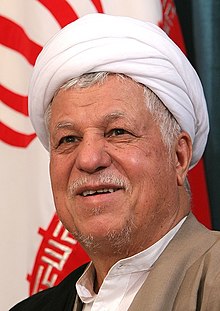Akbar Rafsanjani | |
|---|---|
اکبر رفسنجانی | |
 | |
| 4th President of Iran | |
| In office 16 August 1989 – 3 August 1997 | |
| Supreme Leader | Ali Khamenei |
First Vice President | Hassan Habibi |
| Preceded by | Ali Khamenei |
| Succeeded by | Mohammad Khatami |
| Chairman of Expediency Discernment Council | |
| In office 4 October 1989 – 8 January 2017 | |
| Appointed by | Ali Khamenei |
| Preceded by | Ali Khamenei |
| Succeeded by | Mahmoud Hashemi Shahroudi |
| Chairman of the Assembly of Experts | |
| In office 25 July 2007 – 8 March 2011 | |
| Supreme Leader | Ali Khamenei |
| Preceded by | Ali Meshkini |
| Succeeded by | Mohammad-Reza Mahdavi Kani |
| 18th Speaker of the Parliament of Iran | |
| In office 28 July 1980 – 3 August 1989 | |
| First Deputy | |
| Preceded by | Javad Saeed |
| Succeeded by | Mehdi Karroubi |
| Member of the Assembly of Experts | |
| In office 15 August 1983 – 8 January 2017 | |
| Constituency | Tehran Province |
| Majority | 2,301,492 (5th term) |
| Tehran's Friday Prayer Temporary Imam | |
| In office 3 July 1981 – 17 July 2009 | |
| Appointed by | Ruhollah Khomeini |
| Member of the Parliament of Iran | |
| In office 28 May 1980 – 3 August 1989 | |
| Constituency | Tehran, Rey, Shemiranat and Eslamshahr |
| Majority | 1,891,264 (81.9%; 2nd term) |
| Minister of Interior | |
| Acting 17 November 1979 – 27 February 1980 | |
| Appointed by | Islamic Revolution Council |
| Preceded by | Hashem Sabbaghian |
| Succeeded by | Mohammad-Reza Mahdavi Kani |
| Personal details | |
| Born | Ali Akbar Hashimi Bahramani Rafsanjani 25 August 1934 Bahreman, Imperial State of Persia |
| Died | 8 January 2017 (aged 82) Tajrish, Shemiranat County, Iran |
| Resting place | Mausoleum of Ruhollah Khomeini |
| Political party | Executives of Construction |
| Other political affiliations |
|
| Spouse | |
| Children | |
| Signature |  |
| Website | Official website (in Persian) |
| Military service | |
| Allegiance | Iran |
| Commands | Second-in-command, Joint Chiefs of Staff |
| Battles/wars | Iran–Iraq War |
| Awards | Order of Fath (1st grade)[1] |
Ali Akbar Hashimi Bahramani Rafsanjani[a] (25 August 1934 – 8 January 2017) was an Iranian politician and writer who served as the fourth president of Iran from 1989 to 1997. One of the founding fathers of the Islamic Republic, Rafsanjani was the head of the Assembly of Experts from 2007 until 2011 when he decided not to nominate himself for the post. He was also the chairman of the Expediency Discernment Council.
During his 40-year tenure, Rafsanjani amassed a large amount of power serving as the speaker of parliament, Commander-in-Chief during the Iran–Iraq War, President, and chose Ali Khamenei as the supreme leader of Iran.
Rafsanjani became president of Iran after winning the 1989 election. He served another term by winning the election in 1993. In the 2005 election he ran for a third term in office, placing first in the first round of elections but ultimately losing to rival Mahmoud Ahmadinejad in the run-off. He and his family faced political isolation for their support of the opposition in 2009. Rafsanjani entered the race for the 2013 presidential election,[2] but he was disqualified by the Guardian Council. With Hassan Rouhani's election, in which Rafsanjani openly supported him, the Rafsanjani family gradually recovered their political reputation. Rafsanjani died in 2017, following a heart attack, in a hospital in Tehran at the age of 82. Although government officials attributed his death to cardiac arrest, his sudden death prompted speculation that he had been assassinated. His family strongly asserted that he had been murdered. Further investigation revealed that his body was highly radioactive.[3]
Rafsanjani has been described as a pragmatic Islamic conservative. The Economist called him a "veteran kingmaker".[4] He supported a capitalist free market position domestically, favoring privatization of state-owned industries and a moderate position internationally, seeking to avoid conflict with the United States and the West.[5] He was also the founder of, and one of the Board of Trustees of, Azad University. In 2003, Forbes estimated his personal wealth to be in excess of US$1 billion.[6]
- ^ Poursafa, Mahdi (20 January 2014). گزارش فارس از تاریخچه نشانهای نظامی ایران، از «اقدس» تا «فتح»؛ مدالهایی که بر سینه سرداران ایرانی نشسته است [From "Aghdas" to "Fath": Medals resting on the chest of Iranian Serdars] (in Persian). Fars News. Retrieved 21 October 2014.
- ^ "Iran's Rafsanjani Registers for presidential race". Associated Press. Archived from the original on 11 June 2013. Retrieved 11 May 2013.
- ^ Dehghan, Saeed Kamali (9 January 2018). "Iran reopens investigation into Rafsanjani death". The Guardian. Retrieved 23 June 2021.
- ^ "Iranian politics after the nuclear deal". The Economist. 28 May 2016. Retrieved 29 May 2016.
- ^ RK Ramazani, Revolutionary Iran: Challenge and Response in the Middle East, Johns Hopkins University Press, 1987.
- ^ "Ayatollah Ali Akbar Hashemi Rafsanjani, Ex-President of Iran, Dies at 82". The New York Times. 8 January 2017.
Cite error: There are <ref group=lower-alpha> tags or {{efn}} templates on this page, but the references will not show without a {{reflist|group=lower-alpha}} template or {{notelist}} template (see the help page).